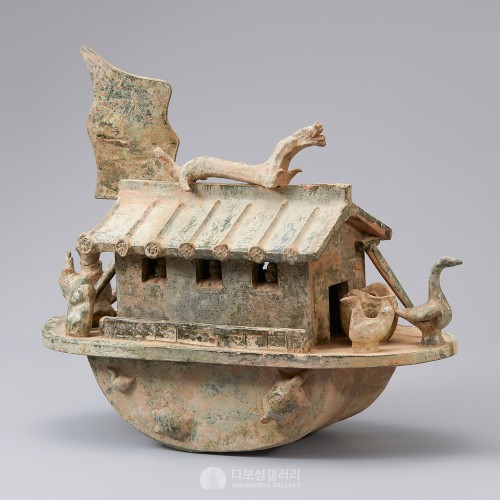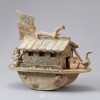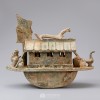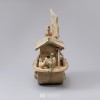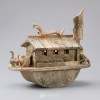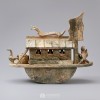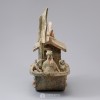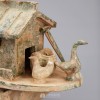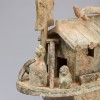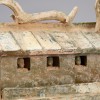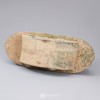작품 정보
한나라 도자와 부장품
한나라 시대에는 사회가 안정되고, 농업과 수공업이 빠르게 발전했으며, 후하게 매장하는 풍습이 민간에서 널리 성행했습니다. 이에 따라 도기 제조업도 활발해져, 대량의 명기(明器)가 제작되어 부장품으로 사용되었으며, 부장품들은 대부분 정교하고 풍부한 구성을 갖추고 있었습니다. 부장품은 죽은 자가 저승에서 사용할 용구라는 점에서 제기(祭器)와 구별됩니다.
부장품 중 소량으로 제작된 석제·금속제·목질칠기 제품을 제외한 대부분은 도기로 만들어졌습니다. 이는 도기가 천 년이 지나도 부패하지 않기 때문입니다. 도기는 단순히 음식 용기로 사용된 것이 아니라, 다락집·창고·부뚜막·수레·배·말·노예 등 다양한 생활 모습을 본뜬 가상의 환경을 조성하는 데 활용되었습니다.
명기 중 대야·항아리·주전자·존(樽, 술통) 같은 기명(器皿)에는 분채(粉彩, 가루 형태의 채색 안료)를 입혔는데, 이는 태토(胎土)와 쉽게 섞이지 않아 조금만 만져도 벗겨질 정도였습니다. 또한, 작은 생활 모형에는 녹유(綠釉)라 불리는 녹색 저온 유약을 입혔는데, 이 유약은 독성이 있어 실제 생활용품에는 사용되지 않았습니다.
한나라 도기 중에서도 와당(瓦當)의 예술적 성취는 특히 두드러졌습니다. 한나라 시대 도자기는 조형이 중후하고 풍만하며, 많은 기형(器形)이 동기(銅器, 청동기)의 형식을 모방했습니다. 도기 표면에는 유약을 칠한 뒤 약 950~1000℃의 온도로 구웠으며, 이로 인해 오늘날 발견되는 도기의 기면(器面)에는 미세한 잔무늬가 남아 있습니다.
한나라에 이르러 우리나라 북방에서 사용된 만두요(馒头窑, 둥근 형태의 가마)는 비교적 완성된 형태를 갖추었으며, 남쪽에서는 용요(龍窯, 용 모양의 긴 가마)가 등장하면서 가마의 규모가 커지고 소성 시간도 단축되었습니다.
한나라 전기의 도기는 진나라 도기와 특징이 비슷하며, 비교적 크고 소박하면서도 생동감이 넘칩니다. 산시(陝西) 함양(咸陽)과 장쑤(江蘇) 서주(徐州)에서 출토된 서한(西漢) 병마용(兵馬俑)의 조형과 진용(秦俑)은 당시의 예술적 풍격을 보여줍니다. 서한(西漢)은 문경지치(文景之治)를 거쳐 한무제(漢武帝) 시기에 절정에 이르렀으며, 이 시기 인문 예술, 자연 과학, 수공업, 제지업, 상업 등이 모두 번영했습니다.
한나라 녹유 도선
이 유물은 한나라(기원전 202년~기원후 220년) 시대에 제작된 선박 모양의 녹유 도선입니다. 배 위에는 궁궐을 상징적으로 표현한 기와집이 웅장한 모습으로 세워져 있습니다. 지붕 위에는 중국을 최초로 통일한 왕실과 국가를 수호하는 용이 하늘을 향해 용트림하고 있으며, 벽에 뚫린 세 개의 창문을 통해 남성의 세상을 바라보는 듯한 모습이 연출되어 있습니다. 창밖을 내다보는 인물상이 있는 녹유선은 매우 드문 사례입니다.
배의 선두(船頭)와 선미(船尾)에는 선장으로 보이는 인물과 함께 배를 고정시키는 닻, 바람을 이용해 배를 움직이는 돛이 놓여 있습니다. 또한, 하늘의 신과 지상을 연결하는 메신저 역할을 하는 새와 배를 이동시키는 노(櫓)도 함께 표현되어 있습니다. 이 유물은 당시 한나라 왕실 문화를 이해하는 데 중요한 자료가 될 뿐만 아니라, 한나라의 뛰어난 선박 제조 기술과 항해 문화를 보여주는 귀중한 유물입니다.
녹유(綠釉)는 도기의 표면에 녹색이나 청색 계열의 유약을 바른 뒤 저온에서 구운 것입니다. 이후, 고온에서 소성하는 청자(靑磁) 유약이 발명되면서 점차 사라졌습니다. 한나라의 녹유 도기는 한반도로도 전해져, 신라 시대에 영향을 미쳤으며, 그 대표적인 유물로 국립중앙박물관에 소장된 <녹유누각연회도용(綠釉樓閣宴會陶俑)> 등이 있습니다.
━━━━━
汉代的随葬品
汉代,由于社会稳定,农业、手工业发展较快,厚葬风气在民间普遍盛行,制陶业大量烧制陶明器用来随葬,大部分随葬品丰富而精细。它与祭器之别在于它是专门供死者在阴间所用而非为生者用具。
陪葬品中除少量石质品、金属制品、木质漆器以外,被大量使用的为陶制品,因为这种材质可历千年而不腐败。除饮食所用的器皿外,大量模拟生活场景,如陶制的楼阁、仓房、灶台、车马、船只、奴仆等等,营造虚幻环境供死者享用。
明器当中的盆、罐、壶、尊之类的器皿,一般都在素坯之外敷设一层粉彩,并不与胎体相融,稍摩擦便脱落;小型生活场景的模型,外表都施加绿色低温铅釉,称为绿釉,当时人们知晓这种铅釉有毒性,所以在日常生活用品中并不使用。
在汉代陶器当中,瓦当的艺术成就也非常突出。汉代的陶瓷器,造型浑厚而饱满,许多器形模仿铜器造型。器物表面施釉烧成温度约在950度到1000度之间,为低温釉,所以今天所见到的汉器表面出现有细微碎纹。
到汉代为止,我国北方使用的馒头窑已基本达到比较完善的地步。在南方,此时已出现比较成熟的龙窑,增大窑室的同时也缩短了烧成时间。
汉代前期的陶塑制品与秦代陶塑风格相近,型体较大,形象生动质朴,栩栩如生。在陕西咸阳、江苏徐州发现的西汉时期兵马俑,其造型、阵容展现出当时的艺术风格。西汉在经过“文景之治”后,在汉武帝时期达到了鼎盛时期。其人文艺术、自然科学、手工业、造纸业、商业、水利等都达到了一个繁荣的时期。
汉代的绿釉陶船
这是一艘汉代(公元前202年~公元220年)制作的绿釉陶船。船上巍然矗立着象征皇宫的瓦屋,呈现出宏伟壮丽的姿态。屋顶上雕刻着守护最早统一中国的皇室与国家的龙,腾空而起,气势磅礴。船壁上开有三扇窗,透过窗户,可以看到人物雕像仿佛在眺望外面的世界。雕刻有眺望窗外人物的绿釉陶船极为罕见。
船首和船尾雕刻着疑似船长的形象,并配有固定船只的锚、利用风力推动船只前进的帆。此外,象征连接天神与人间的信使鸟以及用于划船的橹也被刻画其中。此器物不仅是理解汉代皇家文化的重要资料,也展现了当时卓越的造船工艺与航海文化,极具历史价值。
绿釉是在陶器表面施以绿色或青色系的釉料后,于低温下烧制而成。后来,随着高温烧制釉的发明,绿釉陶器逐渐消失。汉代的绿釉陶器也传入朝鲜半岛,并对新罗时期产生影响,其代表性文物之一为收藏于韩国国立中央博物馆的《绿釉楼阁宴会陶俑》。
━━━━━
Pottery and Burial Objects in the Han Dynasty
During the Han Dynasty, society was stable, and agriculture and handicrafts developed rapidly. The custom of lavish burials was widely practiced among the people, leading to the mass production of mingqi (明器), or burial objects, in the pottery industry. Most burial goods were crafted with great precision and variety. Unlike ritual vessels (jigi, 祭器), burial objects were meant for use in the afterlife.
Apart from a small number of burial goods made of stone, metal, or lacquered wood, the majority were made of pottery, as ceramics do not decay even after thousands of years. These burial objects were not limited to food containers; they also included miniature representations of houses, granaries, stoves, carts, boats, horses, and even slaves, creating an idealized version of daily life for the deceased in the afterlife.
Among the mingqi, vessels such as basins, jars, kettles, and wine containers (zun, 樽) were coated with powder pigments (fenchai, 粉彩). These pigments did not blend well with the clay body and could be easily rubbed off with minimal contact. Additionally, small figurines and household models were coated with green glaze (lüyou, 綠釉), a low-temperature glaze known to be toxic, which is why it was not used for everyday wares.
Among Han Dynasty ceramics, roof tiles and end tiles (wadang, 瓦當) were particularly noteworthy for their artistic achievements. Han pottery was characterized by its robust and full-bodied forms, with many designs imitating the shapes of bronze vessels (dongqi, 銅器). The surfaces of these pottery pieces were glazed and fired at temperatures between 950–1000°C, resulting in the fine, crackled patterns visible on their surfaces today.
By the Han period, the mantou kiln (馒头窑, "steamed bun kiln") used in northern China had reached an advanced stage of development. In the south, the dragon kiln (longyao, 龍窯) had also emerged, allowing for an increase in kiln capacity and a reduction in firing time.
Early Han ceramics shared many characteristics with those of the Qin Dynasty. They were relatively large, simple in form, yet lively in expression. The Western Han Dynasty terracotta army (bingmayong, 兵馬俑) excavated in Xianyang, Shaanxi Province, and Xuzhou, Jiangsu Province, reflects the artistic style of the time. The Western Han Dynasty flourished, reaching its peak under Emperor Wu (Han Wudi, 漢武帝), during which literature, arts, natural sciences, handicrafts, papermaking, and commerce all prospered.
A Green-Glazed Earthenware Model of Boat, Han Dynasty
This green-glazed boat was made during the Han Dynasty (202 BCE–220 CE). The boat features a large, tile-roofed building, symbolizing an imperial palace, standing majestically on its deck. A dragon, representing the ruling family that first unified China and safeguarded the nation, is seen coiling towards the sky atop the roof. Three window openings in the walls allow a view of the external world, depicting a symbolic perspective of the male-dominated society at the time. Green-glazed vessels featuring figures peering out of windows are rare.
At the bow and stern, a captain-like figure is depicted, along with an anchor for securing the boat, a sail for harnessing the wind, and oars for navigation. A bird, symbolizing a messenger between the celestial and earthly realms, is also featured. This artifact is invaluable for understanding Han Dynasty royal culture, as well as the sophisticated shipbuilding and maritime navigation techniques of the time.
Green glaze was created by applying a lead-based glaze that turned green or blue when fired at low temperatures. As high-fired celadon glaze was later developed, green-glazed pottery gradually disappeared. However, Han green-glazed ceramics influenced the Korean Peninsula, particularly in the Silla Kingdom, as seen in artifacts such as the Green-Glazed Pavilion Banquet Figurine, which is now housed in the National Museum of Korea.
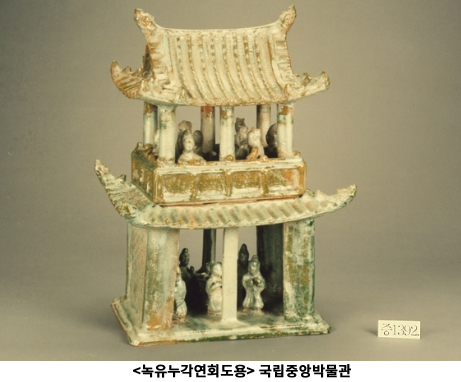
CONDITION
NOTICE
상담/문의 : 02- 730-5601 / 02- 730-7566

